Bitcoin Astronomy
| Crypto Words has moved! The project has migrated to a new domain. All future development will be at WORDS. | Go to WORDS |
Bitcoin Astronomy
By Dhruv Bansal
Posted September 13, 2019
The desire to travel far away and start a new currency will become a powerful driver of human expansion into space.
Earth will run on bitcoin, but colonies on Mars, the outer planets, and distant stars will not. Though faraway colonies will value and trade bitcoin, they will choose to launch, defend and use their own local blockchains. This pattern of replication is an inevitable consequence of hyperbitcoinization and the physical limitations inherent to any blockchain that respects the finite speed of light.
Speculating about the future is always indulgent and never a science, but speculation about tomorrow helps us better understand today. There is a fascinating and rich history of speculation about bitcoin astronomy that we extend and explore in this series. Our aim is to present blockchains and the social, political, & economic structures they produce, as fundamental forces in the universe, on par with evolution, the production of entropy, and the passage of time.
This article focuses on Mars, the Red Planet, and speculates about the economic revolution we foresee occurring there. What happens on Mars will eventually be replicated across the solar system and beyond. But we begin with Earth, in the not-too-distant future, in a post-hyperbitcoinization era.
Hyperbitcoinization on Earth
What does a hyperbitcoinized future Earth settling nearby planets look like? It’s probably a mix of works such as these, but with more bitcoin:
 |
 |
 |
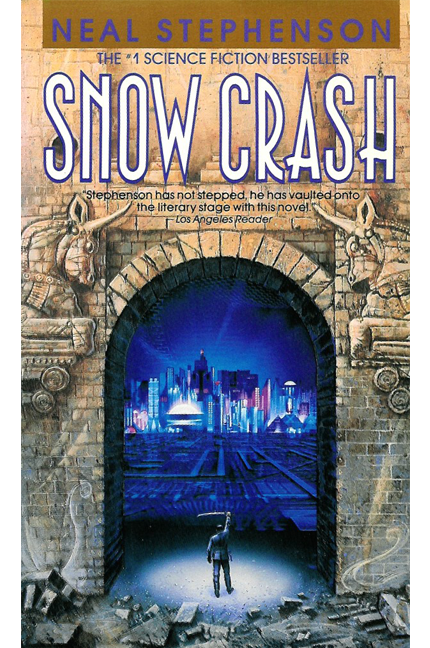 |
| Settlement, terraforming, and revolution on Mars | Conflict between Earth, Mars, and minor powers of Sol. | Rich people will definitely move to space. | A world without nations but a powerful belief in digital reality. |
Imagine it: 100 years from now, bitcoin is a global currency used by all people. Individuals mostly transact on one of several second layer lightning networks. Large transactions still occur on the chain, though usually through aggregation mechanisms. Third and fourth layers also exist: the Internet becomes a bootstrapped mesh network with nodes settling on the lightning network as they store data and push bandwidth. Many powerful global corporations are replaced by inter-operating protocols, all distributed and market-driven, settling to BTC. In a hyperbitcoinized world, bitcoin is not just the foundation of the world economy; it’s the unit of account for new distributed infrastructures of computing, telecommunications, identity, etc.
Hyperbitcoinization is not limited to affecting financial, computer, and social networks. Many other industries will change both in relation to, and independently from, this trend. 20% of world energy production will go to SHA256 hashing because the industries of bitcoin mining and power generation will have merged. The environment is significantly degraded in the future, but it’s not because of bitcoin. Bitcoin mining in 2019 is already utilizing greener energy sources than other industries, and the continued rapaciousness of bitcoin miners for energy will turn out to be the reason fusion power is successfully commercialized, a delicious irony.
In parallel with technological and cultural change will be political revolution. Climate, refugee, and other crises combined with new politics born from new distributed technologies will have transformed the squabbling cathedrals of today’s nations and corporations into a chaotic global bazaar of local polities and loose-knit federations. Empires may still exist, in places, but this is an age of city states.
Humanity started reaching out into space in the 20th century and is doing so again in the 21st. If Elon Musk is successful, we will begin to colonize Mars in the next 20 years. Fast-forward another century: how large could Musk’s Mars colony be?
A century is a very long time, enough to master fusion and deploy macroengineering marvels such as space elevators (and not by nation-states, but by distributed, public corporations chartered through bitcoin). These advances will enable waves of settlers to flee environmental degradation on Earth in search of a better life on Mars. The population of Mars sometime in the 22nd century could easily number in the tens or hundreds of millions.
Will these Martian millions be using bitcoin?
Bitcoin on Mars
Mars will be the first large human colony sufficiently far away for significant light-lag to occur in communications with Earth. This lag will begin as a challenge for explorers, grow into an inconvenience for colonists, and, finally, become a membrane separating two cultures.
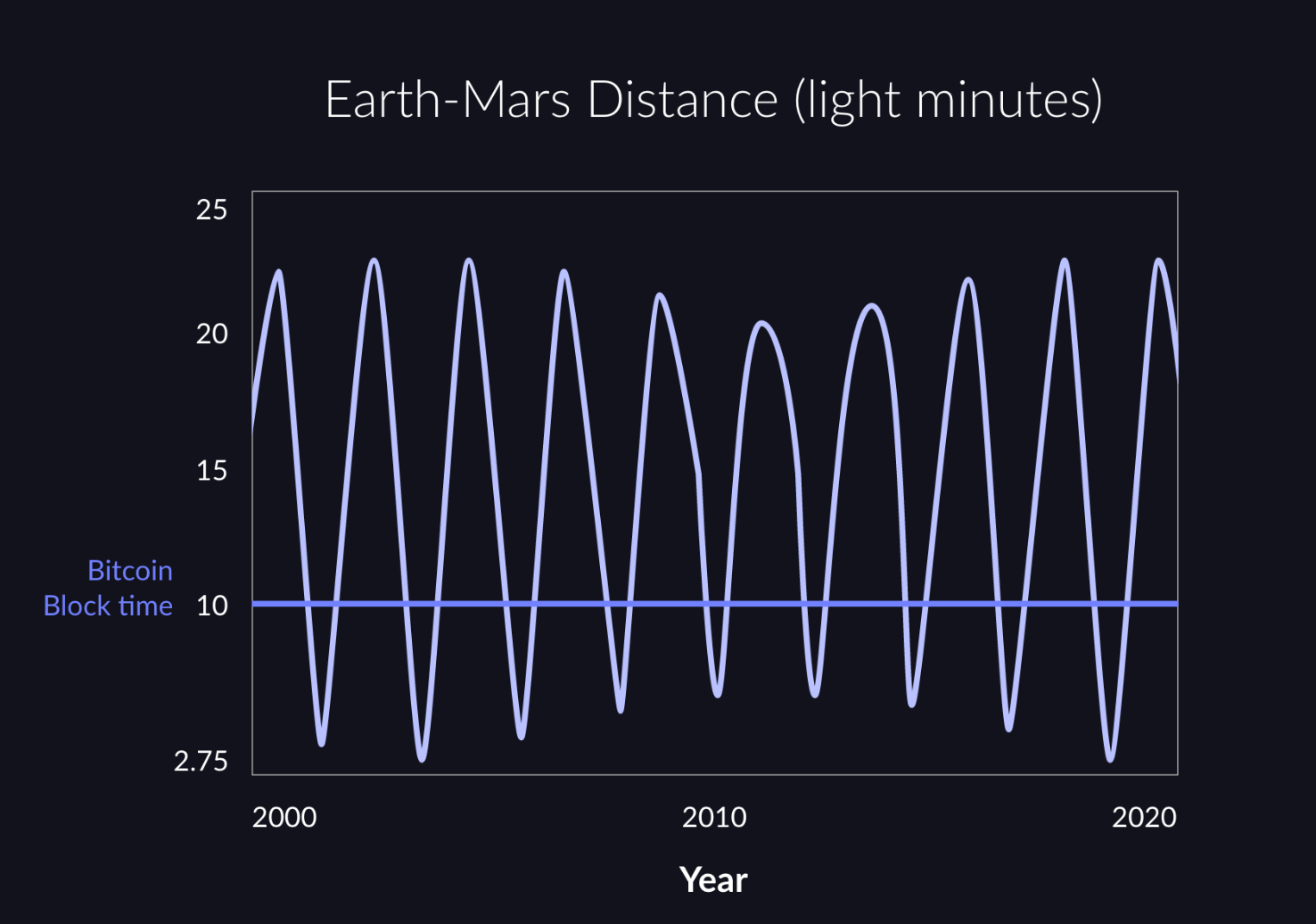 Mars is between 3 & 22 light-minutes away (12.5 light-minutes on average), meaning a round-trip signal time of between 6 and 44 minutes (25 minutes on average). The bitcoin block time is only 10 minutes. (Source)
Mars is between 3 & 22 light-minutes away (12.5 light-minutes on average), meaning a round-trip signal time of between 6 and 44 minutes (25 minutes on average). The bitcoin block time is only 10 minutes. (Source)
Communication between Earth and Mars will certainly still be possible, though networking primitives will be very different than those of today’s Internet (or even the Internet of the then-Earth). A laser-powered, market-driven telecommunications network of relayers and amplifiers will crisscross the inner solar system, trading bandwidth over time and distance for BTC. But there will still be challenges caused by the unavoidable delay inherent to all Earth-Mars communication. Bitcoin users and miners in particular will be affected because of their great distance from Earth and its center of hash:
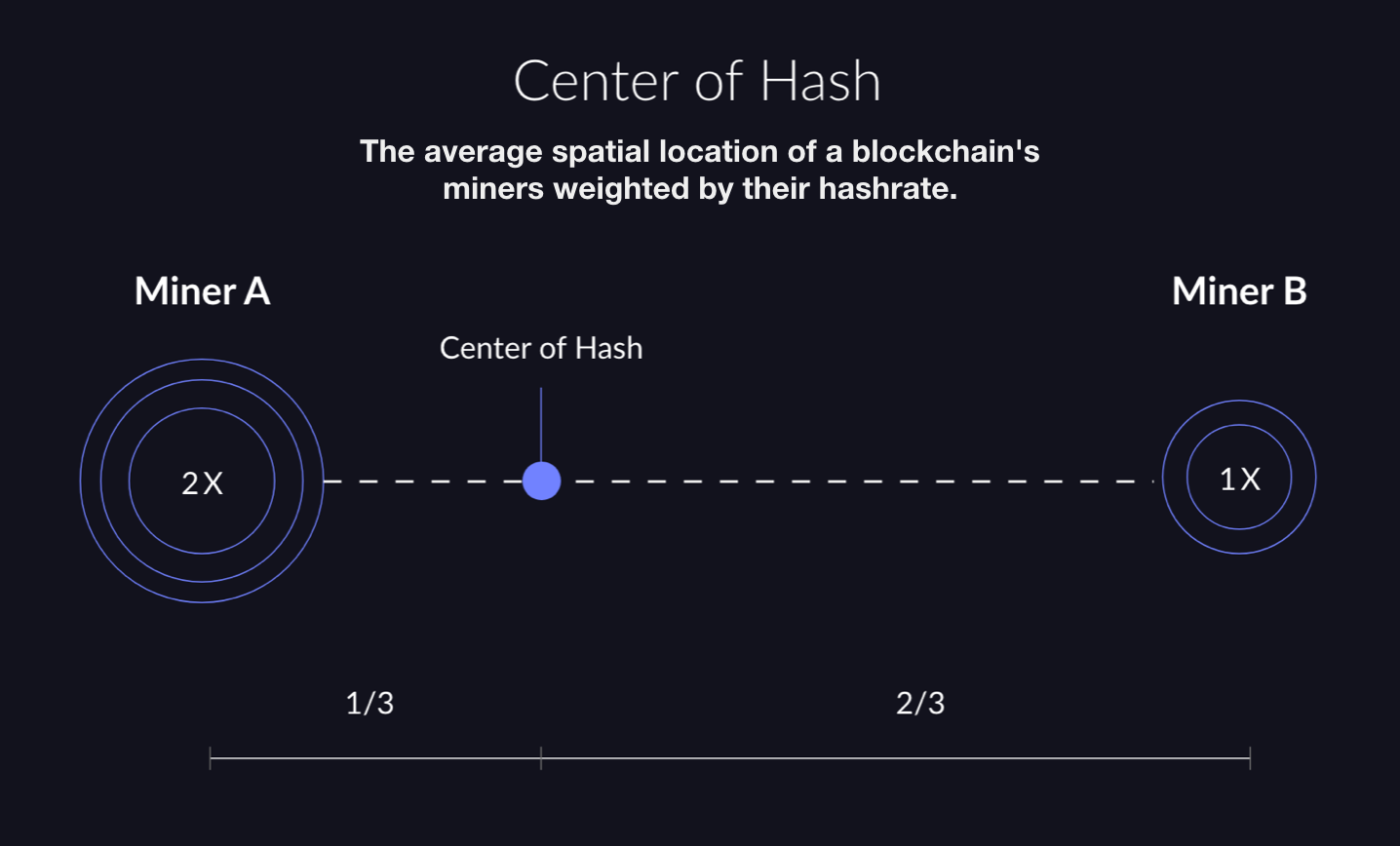 Imagine two miners A & B separated a distance apart. Miner A has twice the hashrate of miner B. Their center of hash will be located at a point in space 1/3 of the distance between them, closer to miner A. A similar calculation can obtain the center of hash for many miners at various hashrates distributed over a large volume of space. Compare to center of mass.
Imagine two miners A & B separated a distance apart. Miner A has twice the hashrate of miner B. Their center of hash will be located at a point in space 1/3 of the distance between them, closer to miner A. A similar calculation can obtain the center of hash for many miners at various hashrates distributed over a large volume of space. Compare to center of mass.
Bitcoin’s center of hash today is somewhere near the center of the Earth, perhaps a bit closer to China. This may change as humanity expands and bitcoin miners set up in orbit or on Luna. But bitcoin’s center of hash is likely to always remain within a few light-seconds distance of the center of the Earth. This will have deep consequences for the future expansion of human civilization.
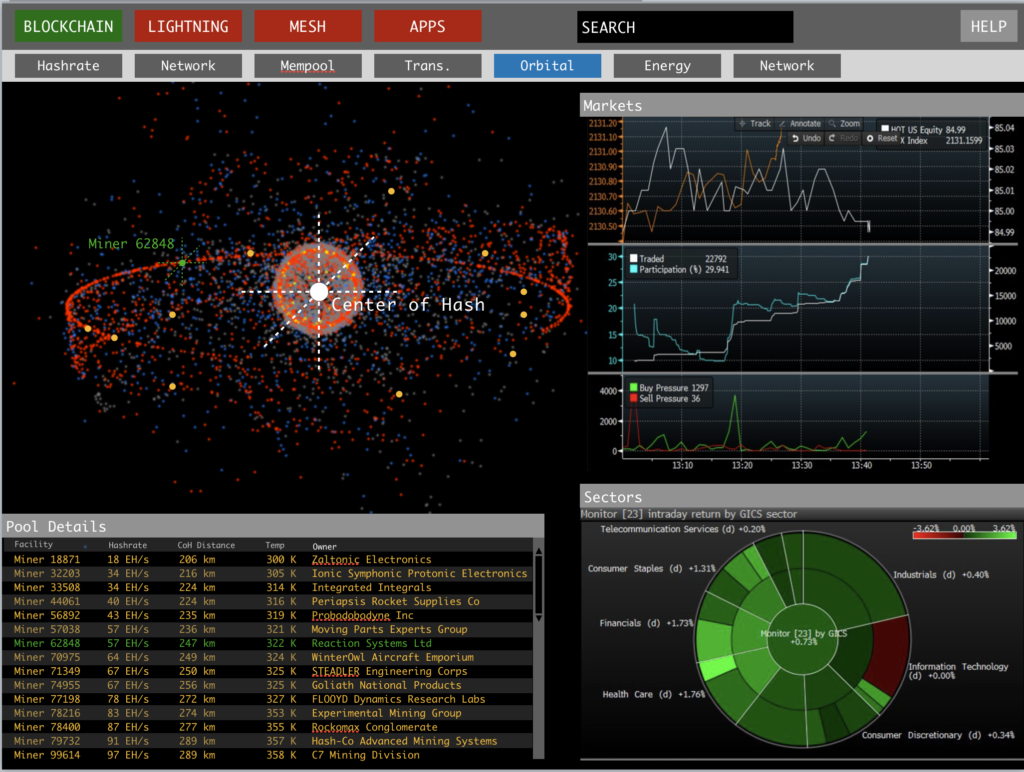 Screenshot of a Bloomberg terminal in 2130. Bitcoin’s center of hash is near the Earth’s center, slightly shifted towards the location of Moon which hosts 15% of all bitcoin miners. (Source)
Screenshot of a Bloomberg terminal in 2130. Bitcoin’s center of hash is near the Earth’s center, slightly shifted towards the location of Moon which hosts 15% of all bitcoin miners. (Source)
Martians will be able to use bitcoin
 A Mariner Valley feed store, circa 2130. All prices are in $atoshis per kilogram. The economy of Mars will initially run on bitcoin. Martians can hold and transact in bitcoin as well as on the higher layer lightning networks.
A Mariner Valley feed store, circa 2130. All prices are in $atoshis per kilogram. The economy of Mars will initially run on bitcoin. Martians can hold and transact in bitcoin as well as on the higher layer lightning networks.
Martians will be able to use bitcoin, lightning networks, and higher layers of the bitcoin ecosystem, but Martians will suffer various small disadvantages compared to Terrans because of their distance from bitcoin’s center of hash.
Firstly, hodling is using: anyone can use bitcoin just by owning some BTC. The first hodler to step on Mars will bring bitcoin to that rusty world. In this way, even though bitcoin’s center of hash is bound to Earth, its reach encompasses the universe.
But Martians can do more than silently hodl. They can run full nodes to help sustain local copies of the blockchain on Mars. They can also transact in bitcoin with each other or with Terrans simply by transmitting signed bitcoin transactions, though they’ll have to wait up to 22 additional minutes for their signals to arrive at the center of hash on Earth.
Most transactions in this era aren’t occurring on the blockchain, but on lightning networks. Martians will be able to use lightning networks, but as Clark Moody points out, they have to take particular care to guard against fraud because of their distance from the center of hash. One tactic might be to choose long lock times for the channels they create and use to route. This may sound like a lot of work, but in a hyperbitcoinized future, the lightning network is old technology; software will handle this constraint behind the scenes.
As Mars grows, so will its lightning network, its third and fourth layers, and their connections to Earth. Martian lightning nodes will earn fees from routing transactions, and Martian disk and server farms will locally cache all the best content from meshflix and apps from the dapp store for Martian use. Yes, there will be constant inefficiency due to Mars’ distance from the center of hash, but for the most part, Martians users will feel as well-integrated into bitcoin and its higher layers as Terrans do.
What about Martian miners?
Bitcoin mining will not be possible on Mars
It will not be possible to mine bitcoin on Mars. The issue is too little hashrate at too far a distance:
Mining Bitcoin on Mars would be unprofitable because of the propagation delay, assuming Earth maintains hash power dominance. The Martian miners would have a view of the blockchain up to 22 minutes out of date, so by the time their latest mined block reaches the majority of hash power on Earth, on average there would be four new blocks added to the chain. — Clark Moody, Bitcoin and the Interplanetary Frontier
The bitcoin network is something like a clock (more on this in Part 3), and it relies on all of its nodes being “in sync” by sharing the same set of blocks and pending transactions. Great distance between miners results in great communication times, difficulty syncing, and the impossibility of mining. A less exotic illustration of this syncing problem exists today and provides an analogy for long communication times in space: If a miner has a poor connection and very limited bandwidth (or blocks are very much larger) then it can take significantly longer for that miner to see the same blocks and transactions as other miners in the network.
Let’s consider an example: A pool of bitcoin miners with, say, 10% of hashrate is located on Earth, near the center of hash. This pool will mine its corresponding fraction of hashrate in blocks: 10% of all blocks. If the pool moves into space very far away, and its distance to the center of hash increases, the pool will find itself winning less than 10% of blocks because of syncing problems caused by communication delays. The further away from the center of hash the pool travels, the lower their fraction of winning blocks. At some distance — some horizon — the pool will no longer win any blocks at all, despite still representing 10% of the hashrate.
We wanted to be more quantitative about the relationships between a miner’s distance from the center of hash, their relative hashrate, the delays they experience in communication, and the resulting weight of blocks they can mine, so we wrote a program called hashwars to simulate these sorts of scenarios. You can find it on GitHub and use it to produce plots such as this one:
 A plot of the relative success of a minority pool of miners at different distances from the center of hash and different relative hashrates compared to the majority. The color plotted shows the fraction (by weight) of blocks mined by a pool at the corresponding distance and relative hashrate. Each point represents the average of many simulations of a bitcoin-like blockchain with a block time of 10 minutes.
A plot of the relative success of a minority pool of miners at different distances from the center of hash and different relative hashrates compared to the majority. The color plotted shows the fraction (by weight) of blocks mined by a pool at the corresponding distance and relative hashrate. Each point represents the average of many simulations of a bitcoin-like blockchain with a block time of 10 minutes.
This plot shows that as a pool of bitcoin miners retreats from the center of hash at Earth, the effectiveness of their hashrate at winning blocks diminishes greatly. Distance protects bitcoin miners on Earth from hashrate that is too far away. This leads us to formulate the following law:
First Law of Bitcoin Astronomy (or “The Law of Hash Horizons”): Given constant hashrate, as a miner moves away from the center of hash of a blockchain, the number of blocks won by that miner statistically trends towards zero.
Vitalik Buterin has written about the Defender’s Advantage conferred by cryptography. The existence of hash horizons confers a similar Hometown Advantage for bitcoin miners. Bitcoin’s block time of 10 minutes was presumably chosen by Satoshi as a compromise between minimizing 1st-confirmation time and chain splits. In making this choice, Satoshi also set the scale of Earth’s hash horizon.
In particular, Mars is outside the hash horizon of Earth. Martians cannot compete in protecting the money they use. This situation is not unique to Mars. Prospective bitcoin miners at any great distance from Earth would be similarly suppressed (and this would have been differently true for other choices of the block time as well). Indeed, in the article above, Clark concludes: Extreme luck aside, the dominant mining planet will remain dominant across the solar system.
The Muskcoin Revolution of 2140
In our view, Clark is partially right. Earth will remain the dominant bitcoin mining planet. But one day Martians will stage a revolution in support of their own token: Muskcoin. If they succeed, then Mars will become the dominant Muskcoin mining planet. The Muskcoin Revolution of 2140 will become a template for other colonies of Earth to follow, just like the American Revolution of 1776 was in its age.
Why Martians will want Muskcoin
Transaction without settlement is tyranny. — Martian revolutionary slogan, 2138
Why would Martians, happily using bitcoin and all its layers, desire to launch their own token? And why would anyone, Martian or Terran, even value such a thing?
In a hyperbitcoinized world, bitcoin has outcompeted all other fiat and cryptocurrencies. Bitcoin is both sound money and substrate for the entire economy. To people of the future, new tokens will seem like foolish scams as no token could have features not already provided by the bitcoin ecosystem, and no token could amass sufficient hashrate to defend against even casual attacks by small bitcoin miners/pools. For people of the future, words like altcoin or staking will sound as silly as nephrology and laserdisc do to us today.
The cynical explanations, preferred by future Terrans and Tories on Mars, will be greed and stupidity. If Muskcoin copied bitcoin, and it succeeded, its early adopters would be rewarded the way early bitcoin miners were rewarded back on Earth in the (now mythical) early years of the 21st century. But Muskcoin supporters will dodge these criticisms and argue that Muskcoin is necessary. Many revolutionaries of this era are second and third generation Martians who have never been to Earth, whose frail bodies could never withstand the harsh pull of Earth’s gravity well. They feel they are their own people, yet Terran control over which bitcoin transactions can settle means they are part of the dominion of bitcoin and, therefore, Earth. Their desire for Muskcoin is the universal desire of all people for self-determination.
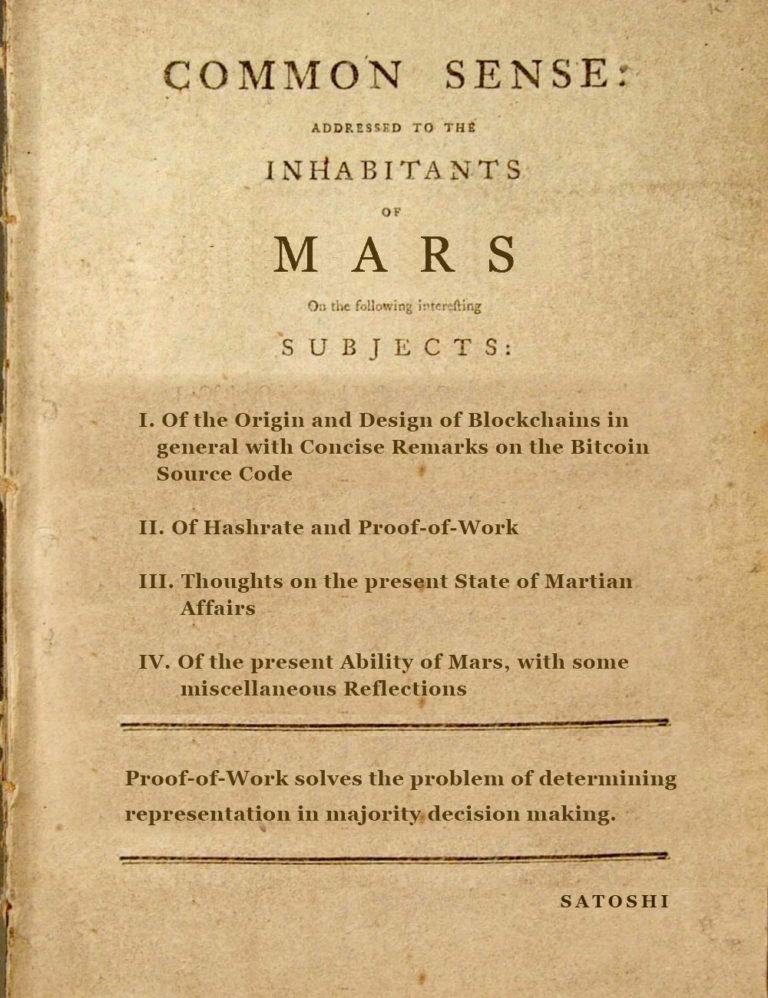
Muskcoin will be modeled on bitcoin and will have many of the same properties. If bitcoin became sound money on Earth, then Muskcoin may become sound money on Mars, and for similar reasons: an intolerant minority of Martians who desire an independent Mars will support its growth.
Muskcoin also has one distinguishing feature not present in bitcoin or in any of its historical altcoins, justifying Martians’ support: Muskcoin will have a center of hash located on Mars.
A center of hash on Mars would allow Martians to develop a Muskcoin mining industry with all its positive effects. In a hyperbitcoinized world, being able to mine on a local blockchain may be a killer feature. As in, a feature worth literally dying for. A feature worth fighting a revolution over.
What will be the revolutionaries’ arguments? Imagine some Martian Thomas Paine’s future version of Common Sense:
- Settlement: Mars is a self-sufficient world full of cashflows generated by our industrious people. Martians run all the shops, factories, and services we rely on ourselves. And Martian reality VR is the most popular content streamed back on Earth! Yes, we manage to keep a few scraps of routing fees, but all the settlement fees from our labors accumulate back in the already full coffers of greedy Terran miners. Keep Martian settlement fees for Martians!
- Energy: Terrans claim Mars is well-supplied through existing trade channels yet we have all seen the lights flicker under the Great Dome of Elon during power crunches. Our heavy metals mining industry is anemic,1` and we are unable to build the power capacity we need. The positive feedback loop between mining and energy production and investment that has been showering Earth with prosperity since the early 21st century must be started here on Mars!
- Fairness: All our settlement transactions must be transmitted through a small number of high-powered comms lasers all of which are owned by perfidious Terran corporations. Native Martian transactions always seem to be enqueued for broadcast behind those of Terrans.
- Censorship: Censoring transactions delays our commerce and endangers our republic. How long before Martian leadership’s transactions are not broadcast at all? By willingly using bitcoin we tie a Terran yoke around our own necks. Are we just serfs in some fiefdom of Earth? Or are we the Children of Mars!?
The narrative of Muskcoin revolutionaries will be part political identity and economic liberation. Intertwined with these themes is the seductive opportunity for those who support the revolution to become a population of “First Miners”, those who win a significant fraction of Muskcoin, the future currency of the Red Planet.
There will be many attempts at Muskcoin
Like any revolution, Muskcoin’s will be chaotic. It may start in fits and bursts and fizzle out again, as Muskcoin efforts fail and are abandoned and renewed again. But eventually some critical mass of supporters and infrastructure will be present and, in a short time, a gaggle of competing Muskcoin contenders will launch, each promoted by various factions on Mars and on Earth with their own interests, all vying for the title of Muskcoin. It will be an age of speculation and charlatanism not seen since the ICO boom of 2017.
Balkanization of Muskcoin into many competing chains will be in the interests of Terran bitcoin maximalists, and some may encourage it. Could Mars unite around some single version of Muskcoin? The fairness of bitcoin’s launch (its immaculate conception) contributed greatly to its success on Earth. Will any Muskcoin be able to replicate these feats on Mars? It’s possible that Satoshi’s disappearance is a one-time trick. But maybe, in this distributed future, successful, open-source anonymous projects with unknown creators are commonplace. There may be established platforms and methodologies for fair launches of all kinds of distributed services with economic incentives to reach stable Schelling points. Operationalized game theory for adversarial systems.
Most Terrans will be indifferent to Muskcoin
Say some Muskcoin contender does emerge from the fray and starts making news on Earth. What would be the reaction of Terrans to Muskcoin? Bitcoin is not government or corporate money; it is money from voluntary consensus forged by users. Muskcoin is, therefore, not a revolution against a government or corporation, but against a voluntary consensus. It is a new political and economic choice, a new Schelling point, in a higher orbit around the Sun.
The future analogues of governments and corporations may have vested interests in bitcoin’s continued use, success, and stability, but the rise of Muskcoin on Mars won’t threaten bitcoin on Earth. Bitcoin will continue to be used by Terrans and Martians alike, even those who support Muskcoin.
As a result, most Terrans will just not care about Muskcoin. They will happily mine and use bitcoin, dismissing reports of a growing Muskcoin user base and hashrate as idle chatter about some duster scam. Some will acquire it as a joke or just to say they have some. As Muskcoin appreciates (relative to bitcoin), it will probably do so in waves, shocking most Terrans. Some will become radicalized against Muskcoin and deliver screeds against it, claiming it has no value or isn’t based on anything or doesn’t work as well as bitcoin or is only used by criminals.
But some Terrans will be Muskcoin enthusiasts. They will recognize the advantages brought to Earth by bitcoin and feel it’s only fair that Muskcoin do the same for Martians. These sympathizers may view a risky new Muskcoin as having potentially outsized returns compared to a mature and stable bitcoin ecosystem with predictable, low yields. Some may invest in Muskcoin, driving its price up relative to bitcoin, or even begin mining it themselves through subsidiaries on Mars.
Finally, some Terrans will be adversely affected by Muskcoin and willing to oppose it. Miners and others close to the energy production & settlement layers of Earth’s bitcoin infrastructure may wish to preserve their transaction fees and control over Martian infrastructure. Some power blocs on Earth may not want Mars to gain further political autonomy. These actors will try and attack Muskcoin.
The Empire Will Strike Back
Could the rise of Muskcoin lead to a shooting war between political blocs on Earth and Mars? Some argue that a bitcoin standard would be a disincentive to large-scale conflict because states would have to resort to direct taxation to pay for their war machines. But history has demonstrated that destructive technologies become cheaper and easier to wield over time. Humans of the future may be just as tribal and easy to incite to stupidity and violence as those of today. A century from now, nuclear technology will be commonplace and some burly faction on Earth could launch a few H-bombs at Mars and obliterate the entirety of its young civilization. This would be effective, but immoral and unwise. Destroying Martian infrastructure would do more collateral damage to the closely linked economy of Earth than the success of Muskcoin ever could have. This is a counter-productive response to the economic threat posed by Muskcoin.
Strong cryptography prevents anyone from stealing Muskcoin, but coordinated factions of Terran bitcoin miners antagonistic towards Muskcoin may have vastly more pooled hashrate than Muskcoin supporters on Mars. This makes it possible for them to launch 51% attacks and attempt to create double-spends on the Muskcoin blockchain. Such an attack might be the analogue of a special forces op against a rogue nation. A precise demonstration of power designed to serve as both temporary setback and warning.
The people of Mars may not be swayed by such displays. Disproportionate, violent responses from empires tend to legitimize the claims of revolutionaries and strengthen their zeal. In this case, antagonistic factions on Earth may have to resort to the ultimate weapon of hash war, the cryptographic analogue of a traditional H-bomb: the hash bomb. A hash bomb is a sequence of empty blocks of tremendous weight mined directly on the genesis block of some blockchain to be destroyed. When a hash bomb arrives at the target blockchain’s center of hash, it immediately triggers a reorg, orphaning all locally mined blocks, and creating a huge upward difficulty adjustment. A hydrogen bomb can reduce a city to its foundations, and fallout makes rebuilding difficult. A hash bomb eradicates the target blockchain’s history, replacing it with a nullscape of empty blocks. The attackers own all the coins and the defenders’ hashrate can only produce a trickle of new blocks at the greatly increased difficulty. Complete and utter economic ruination.
Defenders can’t ignore a hash bomb as its blocks are valid (you may argue that block timestamps would be horribly out of date coming from Earth, but block timestamps are user-defined — Terran miners can always fake them). Defenders could always start a new blockchain but attackers, especially if they have vastly greater hashrate, can just send another hash bomb as soon as they receive the new blockchain’s genesis block.
The Art of Hash War
The art of war teaches us to rely not on the likelihood of the enemy’s not coming, but on our own readiness to receive him; not on the chance of his not attacking, but rather on the fact that we have made our position unassailable. — Sun Tzu
Martian revolutionaries have two significant advantages that they will seek to maximize before they engage in hash war:
- The First Law of Bitcoin Astronomy cuts both ways. As Earth’s hash horizon prevented Martian miners from mining bitcoin, Mars’ own hash horizon is a bulwark against attacks from Terran miners.
- In the future, the bitcoin mining industry is extremely efficient. Most Terran miners will prefer to mine bitcoin and earn settlement fees in bitcoin rather than use their hashrate to attack Muskcoin. Only some fraction of Terran miners will feel sufficiently antagonistic towards Muskcoin to spend hashrate attacking it.
This suggests that the timing of the Muskcoin launch is extremely important. Launch too early, and small pools of antagonistic Terran miners will be able to hash bomb Muskcoin just for the lulz. Long before actually launching Muskcoin, smart Martian revolutionaries will perform simulations to determine whether or not they have sufficient relative hashrate against their Terran adversaries to support a Muskcoin launch. They will produce analyses like the one below (produced with the hashwars program):

The plot shows the fraction (by block weight) of a new blockchain mined (y-axis) by a defender at a given distance (each line) from an attacker as a function of the relative hashrate between attacker and defender (x-axis). Deviation of the plotted lines from the white line (representing zero distance) shows the (dis)advantage conferred by the hash horizon at that distance.
This plot shows the defensibility of a new blockchain given various distances between that blockchain’s defenders and attackers as well as their relative hashrate. At zero distance (the white line) and with 50% relative hashrate, the defenders should win exactly 50% of the blocks by weight (this is the dead center of the plot). Following the white, zero-distance line to the left, as the relative hashrate of defenders decreases, they mine fewer blocks. Following this white line to the right, as their relative hashrate increases, they mine more blocks. At zero-distance, the relationship between hashrate and block weight mined is linear, as expected.
But now look at the red-orange curve for Mars’ distance. At 50% relative hashrate, this curve predicts Martians should mine slightly more than 50% of all blocks. This makes sense because this simulation assumes the blockchain starts at the location of the defender, giving them a small initial advantage. Even though attacker/defender hashrate is evenly split, the Martian’s hash horizon maintains this initial advantage.
Following the red-orange curve for Mars’ distance to the left, when Martian’ defenders have less relative hashrate than attackers, the curve drops faster than the white, zero-distance line. This is a direct consequence of the Law of Hash Horizons — being in the minority at a distance confers a mining disadvantage. Conversely, following the red-orange Mars curve to the right, it rises faster than the white, zero-distance line. This is the Law of Hash Horizons again, but this time the disadvantage is the attackers’ because they have the smaller hashrate. This effect is even more dramatic for the outer planets at greater distances. The further a new blockchain launches from its potential attackers, the less relative hashrate is needed to defend it.
Martians will perform more realistic simulations than those presented here. They will try to plot their own hashrate curve, predicting their chances for success given their hashrate estimates. But are there any other techniques which can adjust the odds in their favor?
Advanced Blockchain Defense Strategies
There are also other techniques Martians can use to boost their resistance against Terran hashrate that require Muskcoin to make some changes to bitcoin’s consensus rules:
- Muskcoin could adopt a different hashing algorithm than bitcoin. Whether this would provide much defense against Terran adversaries depends upon how easily hashrate can be reconfigured or produced in the future. Computing technology could potentially be faster AND more flexible in the future, making specificity/performance trade-offs such as those made by current generation ASICs less relevant: There may be less design space to “get ahead of the current generation of bitcoin miners.” It’s also possible that manufacturing in the future is extremely fast & automated, and that once an ASIC design is known, it’s easy to mass produce in 3d-printing industrial fabricators.
- Muskcoin could merge mine with bitcoin, inserting bitcoin block headers into muskcoin blocks and having muskcoin clients also be bitcoin clients. The weight of a muskcoin block could be defined as including the weight of the bitcoin blocks behind it. This lets Muskcoin piggyback from bitcoin’s existing hashrate and security at the cost of being integrated with it.
- Perhaps in combination with the above strategy, Muskcoin could prohibit long reorgs, dramatically increasing resistance to distance hashrate.
- If a robust, trustless proof-of-location algorithm can be created, it’s possible that new blockchains seeking to resist distance hashrate might demand proof of proximity to a certain location (the core of Mars) before accepting candidate blocks from miners.
In our early era, it’s hard to know what the impacts of the proposals above would be on the consensus behavior and viability of Muskcoin. But in the future, blockchain engineering will be much better understood, a science rather than a dark art. Martians may have other consensus-based defenses which we cannot fathom today.
When Phobos?
When the time is right, Martians will have tools and strategies to help them launch and defend Muskcoin. But when will this be? How long exactly before Muskcoin goes to the Moons? The answer to that question may be also be the answer to another: why is bitcoin’s issuance schedule so long and drawn out?
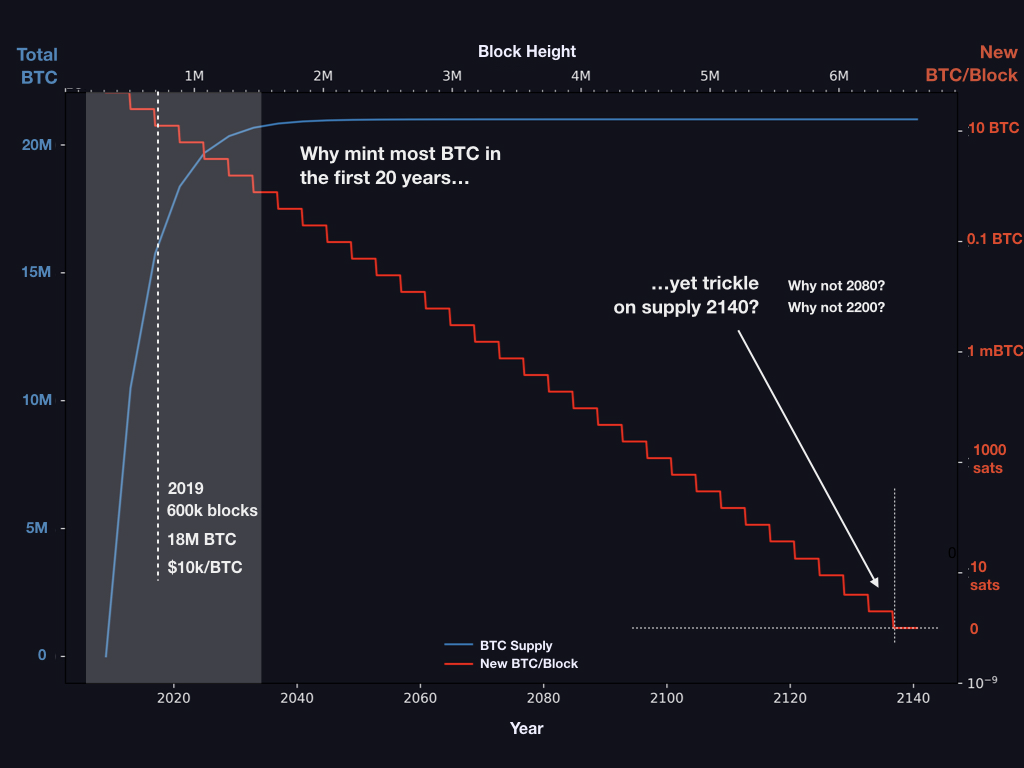 Bitcoin’s supply is mostly produced in its first 20 years. Yet new BTC will continue to be mined (at an ever-diminishing rate) for another 120 years, till 2140. Why did Satoshi pick this timeframe and not, say, 2080 or 2200?
Bitcoin’s supply is mostly produced in its first 20 years. Yet new BTC will continue to be mined (at an ever-diminishing rate) for another 120 years, till 2140. Why did Satoshi pick this timeframe and not, say, 2080 or 2200?
It makes sense that most BTC are minted in the first 20 years of bitcoin’s history — early adopters need to be incentivized to evangelize and build on the network. But why continue to trickle out tiny amounts of BTC per block for another 120 years? Why not 60, or 240? What if Satoshi was trying to estimate something…
Martian Satoshi Conjecture: What if Satoshi designed bitcoin’s block reward schedule to continue minting BTC until the year 2140 when sufficient hashrate is developed on Mars to launch a new blockchain?
Even if this conjecture is false, at some date in the future, the Muskcoin Revolution will succeed. Bitcoin will continue to dominate trade near Earth, but Muskcoin will be used near Mars. Trade between the worlds will rely on cross-chain atomic swaps. The BTC/Muskcoin price, once volatile, will settle to reflect humanity’s collective views on the future of the two civilizations, much as fiat currencies do today but without the ability to manipulate supply.
Bitcoin beyond Mars
Near Sol
The cynicism of Terran nocoiners during the Muskcoin Revolution will be understood as a reasonable stance to have taken given the total hegemony of bitcoin in their lives. After the revolution, everyone will understand that successful human colonies near locations with abundant natural resources that are able to attract settlers and build industry will launch their own blockchains once they have sufficient political will and hashrate. Indeed, becoming a peer in the Solchain network will become the definition of what it means to be a successful colony.
Future econobiologists will see the Muskcoin Revolution as not exceptional but natural. An expanding civilization, limited by light lag, must necessarily become more distributed.
A blockchain makes a strong body for an economy, but it is anchored to its center of hash. When a spore of humanity lands in a far off place, it relies on tenuous connections back to its parent blockchain body. If the location is rich in resources, the spore multiplies and becomes capable of extracting more energy from its environment. Eventually a new blockchain body springs forth, reliant on its own mining metabolism, carrying the genetic imprint of the original chain but now independent. A child body, a daughter chain.
In this way blockchains will seep across the solar system, attracted by energy and resources. Flocks of mobile transport/miners will migrate among the worlds looking for the best way to arbitrage fuel & time across interplanetary hashrate and shipping markets. Humanity will grow like a fungus or slime mold, comfortable in our warm and dark corner of the Milky Way.
(This section was inspired by conversations with and the excellent work of Brandon Quittem.)
Beyond Sol
An Embarrassment of Riches
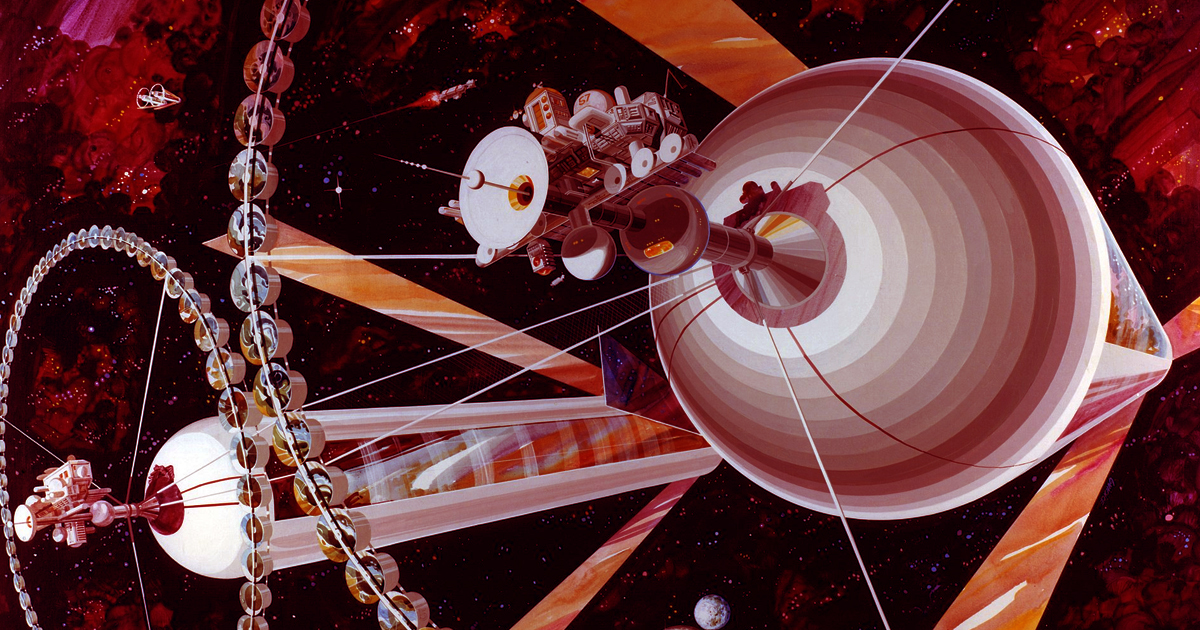 Why would we travel all the way to another star system if we can build anything we need right here at home? (Source)
Why would we travel all the way to another star system if we can build anything we need right here at home? (Source)
What will it take to extend the tendrils of our civilization across the gaps between the stars? Science fiction often presents interstellar colonization as an inevitability of future progress. The more realistic scenario is that humanity will reach some point where interstellar colonization becomes theoretically possible but practically unachievable due to costs. While it may be practical to send small probes quickly, sending thousands of humans and equipment on a years-long journey to another star will be one of biggest investments humanity ever makes. What would be the return?
Consider that there is sufficient matter and energy right here in the solar system to support indefinite growth in human population. Feedstocks of metals, water, and gases are all abundant in asteroids, comets, moons, and the gas & ice giants. We know how to create spin gravity, and the asteroid belt alone has enough raw matter to fashion many thousands of Earths worth of living space in artificial habitats. Fusion powered by water would let us ignite miniature suns for ourselves wherever we choose to live. And we can begin to harvest the enormous power output by the Sun each second, currently lost to space, uncollected by anyone. Why would there be demand to settle new star if our own solar system has infinite supply?
Distance makes the hash grow stronger
 Why settle Alpha Centauri? Because it’s far away.
Why settle Alpha Centauri? Because it’s far away.
The answer again lies in blockchains, distance, and artificial scarcity. While the first Martian settlers were easily able to use bitcoin on Earth, the first settlers of Alpha Centauri would be operating with a 4 year light lag to Earth. This would make bitcoin and any other Solchain unusable by Centaurans far before they even arrived at their destination, while they were still in deep space. Once they arrived at their destination, this light lag would give them a tremendous advantage defending against antagonistic hashrate on Earth. They would be able to start their own blockchain far sooner after their founding than any Solchain in history. In this way, the first settlers of Alpha Centauri would be given two unique opportunities. First, they get to make history by being the first humans to settle another star system. Second, they make fortunes by quickly being able to start and mine their own blockchain. As the Sol system grows more crowded, the perceived return on the investment of a colonization mission will grow. The timeframe for this investment may be a century or more, but the hyperbitcoinized future is one of sound money, low-time preference, and correspondingly long investment horizons.
Mallory was asked “Why climb Mt. Everest?” and his stoic response has become famous, the slogan of explorers and adventurers ever since: Because it’s there. Some future Mallory, head of the first Alpha Centauri settlement mission, will be asked “Why settle Alpha Centauri?” and their response will similarly become famous, an inspiration to countless new colonists: Because it’s far away.
Blockchains incentivize our species to spread far apart, so that great distances may intervene, casting their hash horizons over colonial outposts like dark wings, protecting new, fledgling coins. If this hypothesis is true, it means that bitcoin is more than merely new money.
It is a new driver in the expansion of civilization and will play a bigger role in the future story of humanity than any of us now realize. HODL on.
Beyond Humanity
Stay tuned for Part 2 of this series in which we examine the more universal consequences of these speculations and Part 3 in which we dig into how blockchains will transform our understanding of space and time.
Postscript
A great many people helped make this article possible. Foremost among these are my brilliant and understanding colleagues at Unchained Capital who have my gratitude for participating in and tolerating many wonderful conversations and Slack threads. Ryan Gentry, Taylor Pearson, Tuur Demeester, Buck Perley, Marty Bent, and Brandon Quittem gave me excellent feedback on early drafts. Dan Held, Clark Moody, Grisha Trubetskoy, Murch, David Harding and many others laid the foundation for all this speculation. Thanks to all of you!